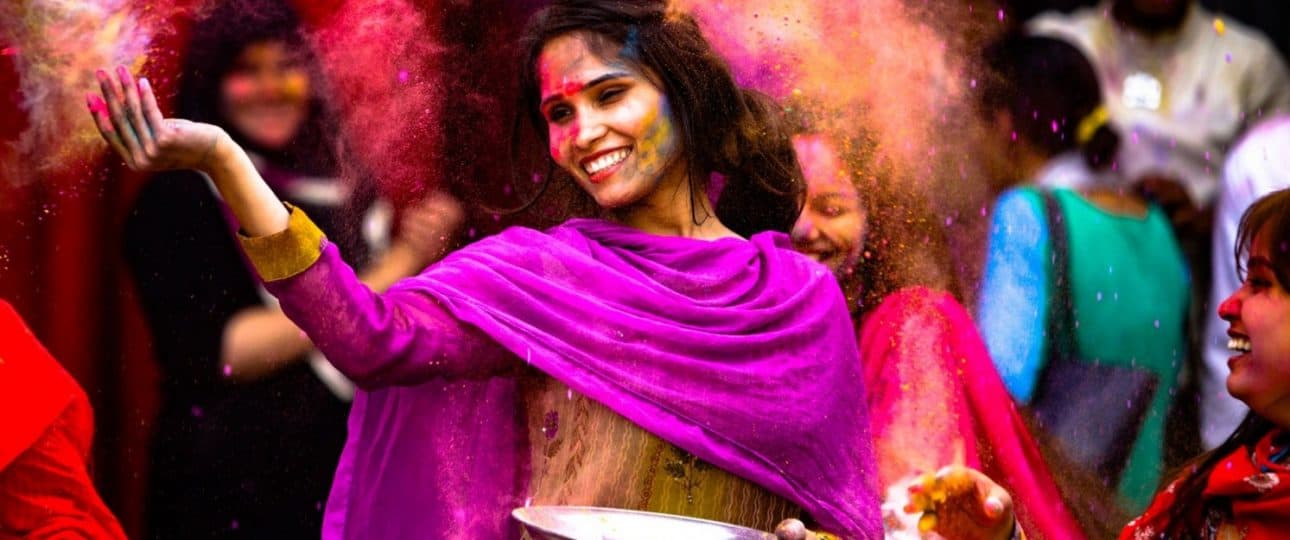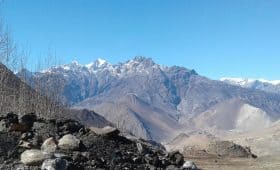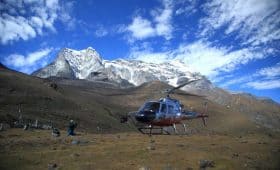Nepal is a small and simple country in terms of size, but more than 125 different ethnic groups live here together. Due to that, almost every day, you can see a group celebrating their typical festivals.
In Nepal, one can see more temples than houses, more gods than people throughout the nation.
Hinduism and Buddhism have more impact on the society. Although there is a vast difference in the ways of both religion, they have successfully co-existed so far.
Unity in diversity is the true essence that has kept this country united as one.
People of this country celebrate different kinds of festivals throughout the year. There is mass participation during these festivals. Everyone is happy and enthusiastic during these special occasions.
Religion plays a vital role in all the festivals. As there are different religions here, everyone has their own reason for celebration. That is why hardly a day passes without any festival being celebrated somewhere.
in this Himalayan country, it is believed that many of the festivals are observed to make the Gods happy.
Some of the festivals are celebrated nationwide, while some among locals and other just among a specific community.
But every festival has its own historical background, legend or folklore that holds its own importance in the Nepalese society.
Table of Contents
Major Festivals of Nepal
Among many of the festival celebrated, some of the major festivals that host mass participation and great importance are listed as follows.
Dashain festival in Nepal
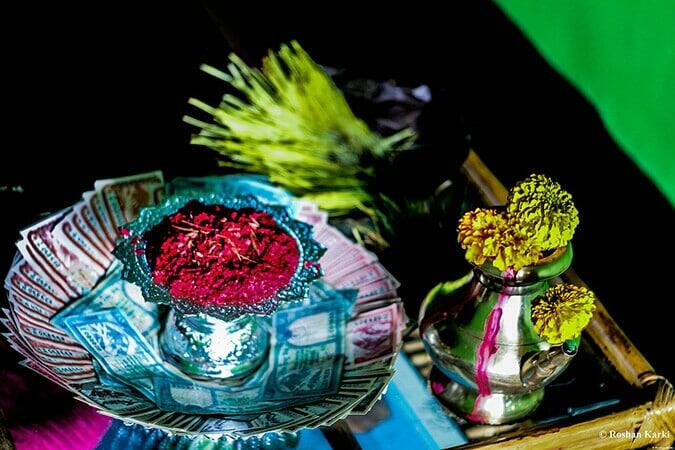
Dashain is one of the major festivals of Nepal. When Dashain arrives, it brings a smile to every Nepalis’ face and brings everyone together. It is over 10-day festival and was the national festival before Nepal became a secular country.
It is still declared a public holiday during the festival. All government offices, educational institutions and other private offices remain closed during this festival.
It is the most auspicious festival which brings all the city people back to their respective villages to celebrate it with their whole family.
The festival falls in the month of September or October (celebrated as per Lunar calendar), starting from the first day of the Shukla Paksha (bright lunar fortnight) of the month of Ashvin and ending on Purnima, the full moon.
The most important days are the first, seventh, eighth, ninth and the tenth, but the tenth day is very important as being the main day of the festival.
People fly kites during the festival. They request the rain God for no more rain as the crops are ready to be harvested.
The main reason why Dashain is celebrated is that it symbolizes the victory of good over evil. Goddessn Shakti is believed to have overthrown the devil during this day.
In Nepal, various ethnic groups have their own way of celebrating this festival.
In general, people decorate their houses, buy new clothes, do shopping, play cards, and celebrate among friends, and family. Dashain should not be missed if you are planning Nepal holiday for family with kids.
Want more information? Send us your query, and our experts will get back to you within 24 hrs.
Tihar festival in Nepal
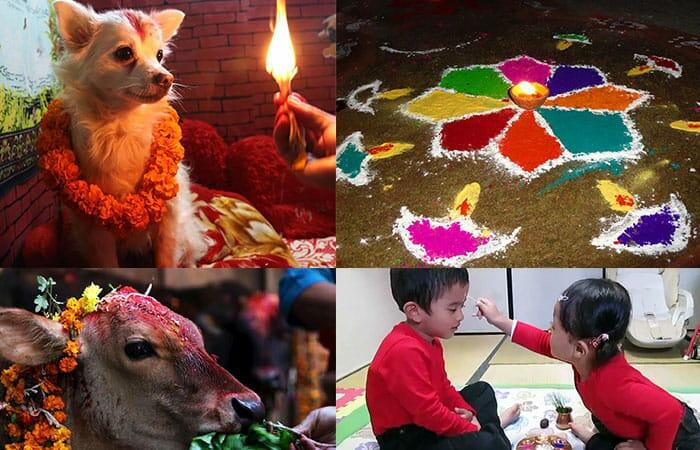
It has many names such as Diwali and Yama Panchak. It is celebrated all over Nepal and some states of India too. It is a five-day long festival.
This is also the festival of lights. During the night, every house is lit with colorful lights and candles. The view is just breathtaking.
Generally, it falls during the month of October.
Tihar is not just a festival of humans to please the god, but it shows reverence to crow, cow, and dog by maintaining an intimate relationship with the animals. The whole day is devoted to them.
The first day is known as Kaag Tihar. People offer sweets and dishes to crows and ravens.
As the cawing of crows symbolizes sadness and grief in Hinduism, so devotees worship them to prevent grief and death befall upon their family.
The second day is Kukur Tihar. Dogs are worshiped on this day. Pet dogs are given a bath and worshiped with garland and delicious food.
Likewise, street dogs are also given garland, tika and good food to eat. As an act of gratitude for the faithful service and good relation between human and dog, this day is celebrated.
The third day is known as Gai Tihar and Laxmi Puja. In the morning, cows are worshiped. They signify prosperity and wealth.
In the evening, the goddess of wealth, Laxmi is worshiped. People light oil lamps or candles on doorways and windows as a gesture of welcoming prosperity and well-being in the family.
From this day, musical performances such as Deusi and Bhailo also start. Boys and girls sing and dance in folk songs in between fireworks and celebration.
The fourth day is known as Govardhan puja. Govardhan mountain is worshiped by taking cow dung as its representative. While in the Newar community, people celebrate Mha puja by worshiping their own bodies.
The main and the last day of the Tihar is Bhai Tika. Brothers receive tika from their sister on their forehead as a way of thanking for all the protection, love and support they have provided and also, to ensure their long life.
And brothers offer money and gifts in return.
Nepali New Year
The official calendar adopted by the Nepalese is the Bikram Sambat (B.S.). The Bikram Sambat New Year begins in the month of Baisakh (mid- April).
This day is celebrated as a new beginning, welcoming the new year with friends, families, and relatives with lots of food. This is one of the biggest festivals in the Nepalese society.
While everyone celebrates this day, the biggest celebration is marked in Bhaktapur, the city of Devotees. The celebration in Bhaktapur goes on for a week in the name of Bisket Jatra.
A huge chariot of Bhairav, the aggressive form of Lord Shiva is taken around the town and pulled by thousands of people.
People have their own new year resolution plans. With new energy and excitement, they look back to the past year, bid farewell and welcome the new one with open hearts.
Just like many other countries, Nepalese commemorate this event with the hopes of peace and prosperity as they face the New Year.
Lots of activities such as street dances, parades, and reunions take place which is funded by organizations and individuals both.
It is believed that if you spend the first day of the year nicely and wisely, all your upcoming days will be as good as the New Year.
Holi festival in Nepal

This festival is basically celebrated all over Nepal and India on different dates. It is an ancient holy religious festival. Also, known as the festival of colors, it is one of the most interesting and refreshing festivals.
It signifies the victory of good over evil, the start of the spring season, as a thanksgiving for a good harvest. People dance, laugh, play, meet, forgive and move on from the past and broken relationships.
It is celebrated during the month of Falgun (end of February). Basically, it is a one-day festival starting on the evening of the Purnima (full moon day) and ending the next day.
There is no any caste or religion barrier in this festival. Anyone who is willing can freely enjoy the festival.
Like all the other festival, it has its own legend. In ancient times, Holika, the sister of the demon king Hiranyakashipu was burned alive to death.
Then, people gathered together and performed rituals in front so as to kill the internal evil that lives inside them. People light candles and perform the puja.
The fun part of the festival happens the next day. It is celebrated as a Rangwali Holi. People splash different colors at each other’s faces. They also dance and sing along to the rhythm of different tunes.
On the other hand, kids mainly play with water-filled balloons and water guns. The whole city is filled with colors and this is the reason why it is known as the festival of colors.
Colors bring people together and they share the happiness. Local concerts are held, where many people along with foreigners gather to enjoy the festival.
In the evening, people take a quick bath, put on warm clothing and sit around the fire to enjoy the warmth. They chat with each other, share stories, and crack jokes.
Lhosar festival in Nepal
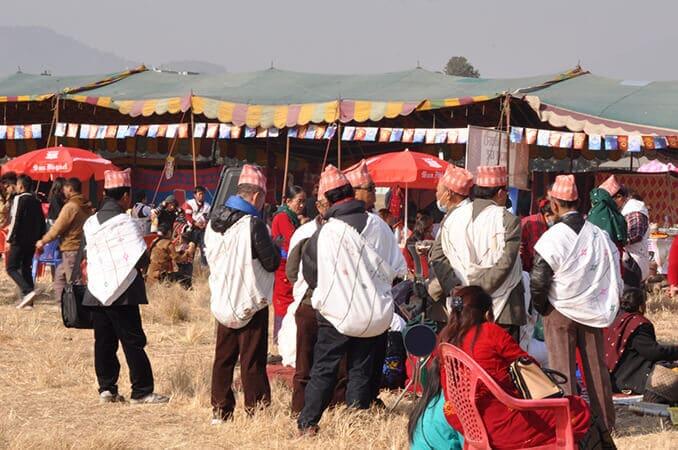
Lhosar is a festival celebrated by the Northern Buddhist community. There are generally many types of Lhosar. They are celebrated on different dates according to the location and tradition.
It is a new year festival celebrated on the first day of the lunisolar Tibetan calendar (February or March).
This festival dates back thousands of years and it has managed to survive so long time and will continue to.
According to history, Lhosar predates the arrival of Buddhism in Tibet.
The different types of Lhosar celebrated in Nepal can be listed as:
- Tamu Losar
- Sonam Losar
- Gyalpo Losar
They are all celebrated on different dates by different ethnic group among the Buddhists. During the respective days, everybody, in general, wears their traditional dress and prepares a variety of feast.
All family members come together, sing, dance and enjoy the day with a full heart.
Traditional cuisine stalls and rallies are also organized throughout the country. They visit the nearest Gumbas, offer money and food to beggars, and pray for a good year.
Gai Jatra festival in Nepal
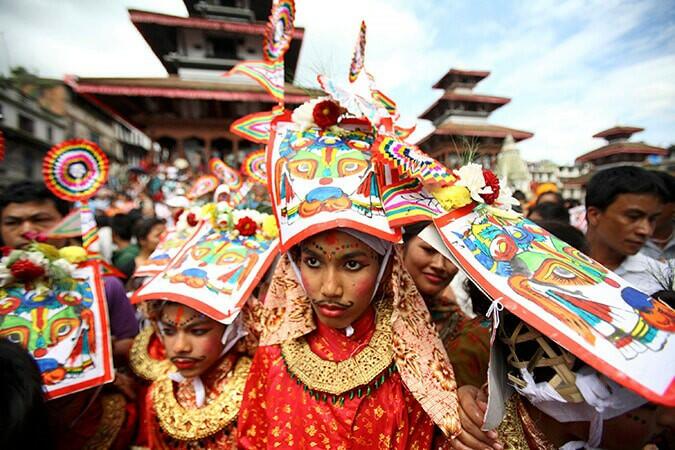
The simple translation of the word is ‘the festival of cows’. This festival is mainly celebrated in Kathmandu valley, especially by the Newar and Tharu communities. It is celebrated to commemorate the death of people during the year.
The day is devoted to them, in their memory and the well-being of the spirit. It falls in the month of Bhadra (Aug-Sep).
During the festival day, cows march in the street. Generally, the son from each family is dressed and made up as a cow. The boys are teenagers or a child who march on the streets with their family by their side.
They are carried on a small chariot or walk on foot to certain areas. People offer food, sweets, money, and peasants. They go on collecting all the offerings.
After the procession is over in the afternoon, many take part in another age-old tradition in which the participants dress up and wear masks. The occasion is filled with songs, dances, and jokes.
Mockery and humor of every subject become the order of the day until late in the evening. All the fun makes the crowd go crazy with laughter.
According to tradition, every family who has lost a member or relative in the past year must take part in it. It is just so as to share the grief with everyone in a hope that the pain will lessen.
In Patan area, young girls are also dressed up as a cow during this day.
The main reason why it is celebrated and who started can be known by the history of the Kathmandu. According to historical evidence, when King Pratap Malla lost his son, his wife, the queen, remained grief-stricken.
The king was very sad to see the condition of his beloved queen.
The king, in spite of several efforts, could not lessen the grief of his wife. He desperately wanted to see a little smile on the lips of his sweetheart, and so he announced that anyone who made the queen laugh would be rewarded adequately.
Since that day, every year it was celebrated as Gai Jatra.
Hence, Gaijatra is a healthy festival which enables the people to accept the reality of death and to prepare themselves for life after death.
Even though the large of the population in Nepal live a marginalized life, that does not stop them from celebrating festivals. Rich or poor, everyone celebrates these festivals with full enthusiasm and smiles.
These all the festivals are just an escape from the everyday monotonous life. And, a reflection on the life and everyday values, beliefs, and lifestyles of the various ethnic groups.
Want more information? Send us your query, and our experts will get back to you within 24 hrs.
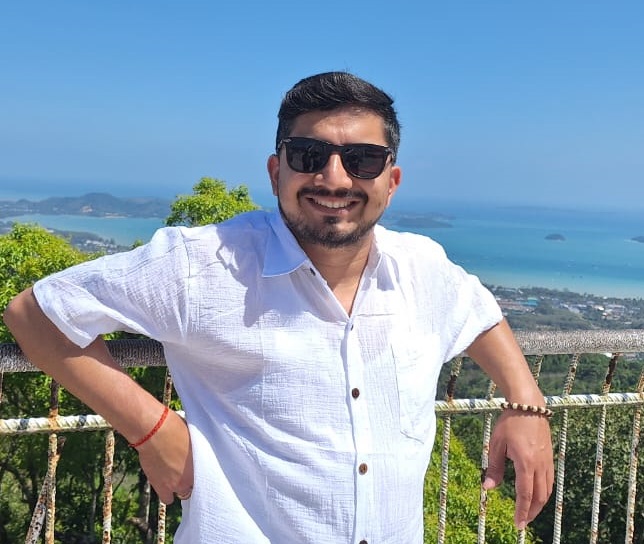
Madhav started working as a porter in 2001 and then moved on to work as a trekking guide. After working in the trekking and tourism industry for eight years, he co-founded Mosaic Adventure in 2009.
Madhav has trekked to most of the trekking destinations in Nepal, including Everest Base Camp Trek, Annapurna Base Camp, Annapurna Circuit Trek, Poon Hill Trek, Jomsom Muktinath Trek, Indigenous Peoples Trek, Langtang Valley Trek, Mardi Himal Trek, and all of the day hikes around Kathmandu.
He has also extensively traveled to other countries such as Australia, the USA, the UK, France, Hong Kong, Japan, China, the Philippines, the UAE, Saudi Arabia, Bahrain, Thailand, Turkey, and India. Madhav is the one who answers most of your questions about trekking and tours and helps to plan your trip by giving a personal touch.

